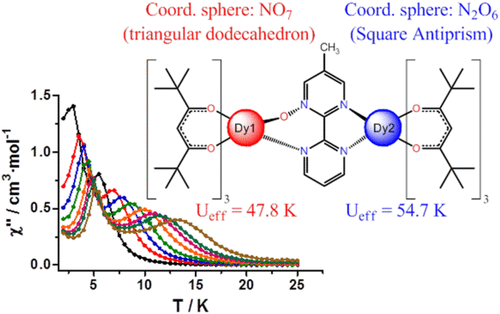当前位置:
X-MOL 学术
›
Inorg. Chem.
›
论文详情
Our official English website, www.x-mol.net, welcomes your
feedback! (Note: you will need to create a separate account there.)
Designing a Dy2 Single-Molecule Magnet with Two Well-Differentiated Relaxation Processes by Using a Nonsymmetric Bis-bidentate Bipyrimidine-N-Oxide Ligand: A Comparison with Mononuclear Counterparts
Inorganic Chemistry ( IF 4.3 ) Pub Date : 2018-05-18 00:00:00 , DOI: 10.1021/acs.inorgchem.8b00427 Ismael F. Díaz-Ortega 1 , Juan Manuel Herrera 1 , Daniel Aravena 2 , Eliseo Ruiz 3 , Tulika Gupta 4 , Gopalan Rajaraman 4 , H. Nojiri 5 , Enrique Colacio 1
Inorganic Chemistry ( IF 4.3 ) Pub Date : 2018-05-18 00:00:00 , DOI: 10.1021/acs.inorgchem.8b00427 Ismael F. Díaz-Ortega 1 , Juan Manuel Herrera 1 , Daniel Aravena 2 , Eliseo Ruiz 3 , Tulika Gupta 4 , Gopalan Rajaraman 4 , H. Nojiri 5 , Enrique Colacio 1
Affiliation

|
Herein we report a dinuclear [(μ-mbpymNO){(tmh)3Dy}2] (1) single-molecule magnet (SMM) showing two nonequivalent DyIII centers, which was rationally prepared from the reaction of Dy(tmh)3 moieties (tmh = 2,2,6,6-tetramethyl-3,5-heptanedionate) and the asymmetric bis-bidentate bridging ligand 4-methylbipyrimidine (mbpymNO). Depending on whether the DyIII ions coordinate to the N^O or N^N bidentate donor sets, the DyIII sites present a NO7 (D2d geometry) or N2O6 (D4d) coordination sphere. As a consequence, two different thermally activated magnetic relaxation processes are observed with anisotropy barriers of 47.8 and 54.7 K. Ab initio calculations confirm the existence of two different relaxation phenomena and allow one to assign the 47.8 and 54.7 K energy barriers to the Dy(N2O6) and Dy(NO7) sites, respectively. Two mononuclear complexes, [Dy(tta)3(mbpymNO)] (2) and [Dy(tmh)3(phenNO)] (3), have also been prepared for comparative purposes. In both cases, the DyIII center shows a NO7 coordination sphere and SMM behavior is observed with Ueff values of 71.5 K (2) and 120.7 K (3). In all three cases, ab initio calculations indicate that relaxation of the magnetization takes place mainly via the first excited-state Kramers doublet through Orbach, Raman, and thermally assisted quantum-tunnelling mechanisms. Pulse magnetization measurements reveal that the dinuclear and mononuclear complexes exhibit hysteresis loops with double- and single-step structures, respectively, thus supporting their SMM behavior.
中文翻译:

通过使用非对称双双双嘧啶-N-氧化物配体设计具有两个完全不同的弛豫过程的Dy 2单分子磁体:与单核对应物的比较
在这里,我们报告双核[(μ-mbpymNO){(tmh)3 Dy} 2 ](1)单分子磁体(SMM),显示两个非等价的Dy III中心,该中心是根据Dy(tmh)3的反应合理制备的部分(tmh = 2,2,6,6-四甲基-3,5-庚二酸酯)和不对称双齿桥联配体4-甲基联嘧啶(mbpymNO)。取决于Dy III离子是与N ^ O还是N ^ N二齿供体对配位,Dy III位点呈NO 7(D 2 d几何)或N 2 O 6(D 4 d)协调领域。结果,观察到两个不同的热激活磁弛豫过程,其各向异性势垒分别为47.8和54.7K。从头算计算确认了两种不同弛豫现象的存在,并允许将47.8和54.7 K的能垒分配给Dy(N 2 O 6)和Dy(NO 7)位置。为了比较目的,还制备了两种单核络合物,[Dy(tta)3(mbpymNO)](2)和[Dy(tmh)3(phenNO)](3)。在这两种情况下,Dy III中心均显示NO 7配位范围,并且在U eff下观察到SMM行为值分别为71.5 K(2)和120.7 K(3)。在所有这三种情况下,从头算都表明,磁化的弛豫主要是通过奥巴赫,拉曼和热辅助量子隧穿机制产生的第一个激发态Kramers双峰发生的。脉冲磁化测量表明,双核和单核复合物分别显示出具有双步和单步结构的磁滞回线,从而支持了它们的SMM行为。
更新日期:2018-05-18
中文翻译:

通过使用非对称双双双嘧啶-N-氧化物配体设计具有两个完全不同的弛豫过程的Dy 2单分子磁体:与单核对应物的比较
在这里,我们报告双核[(μ-mbpymNO){(tmh)3 Dy} 2 ](1)单分子磁体(SMM),显示两个非等价的Dy III中心,该中心是根据Dy(tmh)3的反应合理制备的部分(tmh = 2,2,6,6-四甲基-3,5-庚二酸酯)和不对称双齿桥联配体4-甲基联嘧啶(mbpymNO)。取决于Dy III离子是与N ^ O还是N ^ N二齿供体对配位,Dy III位点呈NO 7(D 2 d几何)或N 2 O 6(D 4 d)协调领域。结果,观察到两个不同的热激活磁弛豫过程,其各向异性势垒分别为47.8和54.7K。从头算计算确认了两种不同弛豫现象的存在,并允许将47.8和54.7 K的能垒分配给Dy(N 2 O 6)和Dy(NO 7)位置。为了比较目的,还制备了两种单核络合物,[Dy(tta)3(mbpymNO)](2)和[Dy(tmh)3(phenNO)](3)。在这两种情况下,Dy III中心均显示NO 7配位范围,并且在U eff下观察到SMM行为值分别为71.5 K(2)和120.7 K(3)。在所有这三种情况下,从头算都表明,磁化的弛豫主要是通过奥巴赫,拉曼和热辅助量子隧穿机制产生的第一个激发态Kramers双峰发生的。脉冲磁化测量表明,双核和单核复合物分别显示出具有双步和单步结构的磁滞回线,从而支持了它们的SMM行为。











































 京公网安备 11010802027423号
京公网安备 11010802027423号